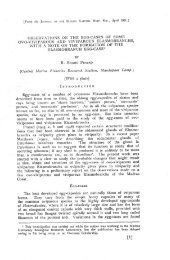PDF - Eprints@CMFRI
PDF - Eprints@CMFRI
PDF - Eprints@CMFRI
You also want an ePaper? Increase the reach of your titles
YUMPU automatically turns print PDFs into web optimized ePapers that Google loves.
104<br />
1939. UM8GROVE . 25 ; pI. 2/1.<br />
1976. PILLAI & SCHEER, 54 ; pI. 2412.<br />
1977, VERON , PICHON & WIJSMAN·8EST. 18; figs. 1l- 15 .<br />
PW 71 333 is an entire colony with a greater spread of 10 cm and a total height of only 5 cm. The<br />
branches are short, 3 to 3.5 cm long each, main division with 2 or 3 monocentric corallites. Corallites<br />
rounded or a little elongated, 12 to 15 mm in diameter, 4 to 5 mm deep. Total number of septa 40 to 44,<br />
excluding a set of spiny ones. Major septa exsert, exsert ends vertical, 1.5 mm. Septa broader below, edges<br />
of septa dentate. Subsidiary septa unite to the major ones, the last tooth often forms a paliform lobe.<br />
Septa slightly swollen at the wall , sides granular.<br />
PW 71351 is a young colony with 9 monostomodaeal corallites. The colony is phaceloid, but the<br />
branches are shorter than in PW 71 33 3. Corallites oval or elongated , larger ones up to 20 mm in diameter.<br />
Larger septa up to 2 mm exsert.<br />
Material :<br />
Gulf of Aqaba : Basel PW 71333 , 351 (Fara'un lsI. , 40 m) .<br />
Dis t rib uti 0 n : Red Sea ; Madagascar; Maldives; Philippines; Japan; Bonin Isis. ; NW-Australia; Great<br />
Barrier Reef; New Caledonia (?).<br />
Rem a rk s : This is the first record of this species and genus from Red Sea .<br />
Genus Erythrastrea PICHON , SCHEER and PI LLA I<br />
Type species : Erythrastreaj1abellata PICHON , SCHEER & PILLA!.<br />
G e n e ric c h a r a ct e r s : Phaceloid , branches flabellate, compressed, epithecate. Wall thin. Calices<br />
meandering, valleys short or long and sinuous, S to 10 mm wide, 4 to 5 mm deep. Columella centres<br />
distinct, formed of septal fusion , adjacent ones linked by indistinct lamellae. Septa exsert vertically,<br />
edges dentate. Costae very conspicuous, extend to the base of the flabellate branches, often linked by<br />
transverse ridges.<br />
Erythrastrea is similar to Cau/astrea in the details of septa and columella characters, but differs in<br />
having a very distinct growth form as well as long and sinuous valleys. In having flabellomeandroid coralla<br />
with columella centres linked by lamellae this genus resembles Tra chyphyllia. But the septal nature as<br />
well as the form of the corallum are entire distinct, the septa have no inner lobe, a characteristic of<br />
Trachyphylliidae. The present genus certainly belongs to Faviid ae, and its closest relative is Cau/astrea.<br />
Erythrastrea flabellata PICHON, SCHEER and PILLAI, in press.<br />
(Pl ate 26. Figs. 3. 4)<br />
Erytbrastf'ea Jlabe/JotQ (? 1983), PICHON , SCHEER & PILLAI, in press.<br />
Wa 75 is composed of two flab ell ate branches with a total height of 12 cm . Width at the top 8 cm , at<br />
the b ~ se 2.5 cm. The two branches are compressed, thickness at the mid-height 10 mm . An epitheca<br />
covers most of the surface, except the extreme top. Wall 0.5 to 0.75 mm thick. Costae correspond to<br />
major septa, elevated , extend to the base of the branch. There are many transverse ridges connecting the<br />
costae. Each branch bears a single valley. Valleys sinuous, 7.5 and 3 cm respectively, when measured<br />
straight. Width of valleys 5 to 9 mm at different pam, depth 5 to 6 mm .<br />
Septa alternating in size , secondaries spiny, 6 to 8 major septa per cm length of wall. Major septa<br />
exsert to 2 mm, exsert part vertical, rounded at the top. Septa broader at the upper half, thinner below;<br />
a constriction is visible at the mid-length, but there is no paliform lobe. Broader parts of septa with<br />
mi croscopic serrations at the edges, lower down with 2 to 3 teeth. Sides of septa granular. Adjacent septa<br />
sometimes fusing together. Columella centres distinct, trabecular; major septa unite with the columella.<br />
Adjacent centres on an average 1 cm apart, linked by weekly developed lamellae.<br />
NS 6062 is represented by a single compressed branch with a total height of 4.5 cm . It bifurcates at<br />
the top and has two valleys,S and 2 cm long respectively. Width of valleys 8 to 11 mm, depth 5 mm. The<br />
major septa a little thickened at the wall, the subsidiaries are better developed than in Wa 75 and fuse to
















